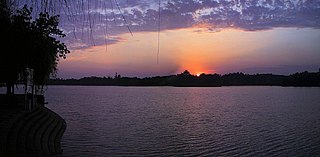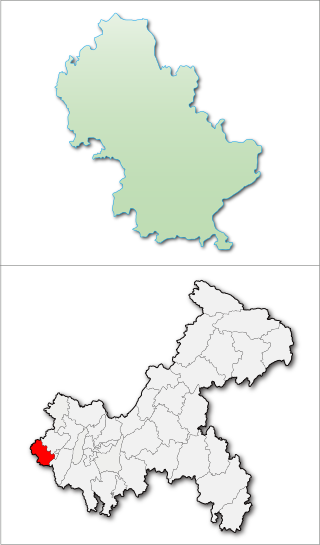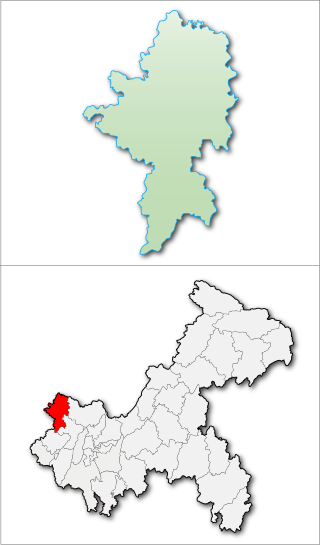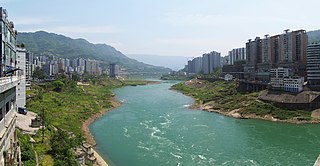
Sihui, formerly romanized as Szewui, is a county-level city in the west of the Pearl River Delta region in Guangdong province, China. It is administered as part of the prefecture-level city of Zhaoqing. Sihui's population is 640,910 in 2020.

Hechuan is a district in the northern part of Chongqing Municipality, People's Republic of China, located at the meeting point of the Jialing, Fu and Qu rivers, with a history of 1,500 years. Hechuan is 54 km (34 mi) away from downtown Chongqing's Yuzhong District.

Sanshui District, formerly romanized as Samshui, is an urban district of the prefecture-level city of Foshan in Guangdong province, China. It had a population of 622,645 as of the 2010 census. It is known for the "Samsui women", emigrants who labour in Singapore, and for a large fireworks explosion in 2008.

Pukou District, is one of 11 districts of Nanjing, the capital of Jiangsu province, China, lying northwest across the Yangtze River from downtown Nanjing.

Beibei District is a district in the Chongqing municipality, People's Republic of China. A satellite town in the north of central Chongqing, Beibei got its name because of the huge rock that extends to the middle of Jialing River, and is known for its historical culture in the period of the Republic of China. It covers around 755 square kilometers (292 sq mi) and has a population of about 834,887 (2020).

Changshou is a district in Chongqing, China, located by the Yangtze river, with a history spanning several thousand years. Changshou is 80 km (50 mi) from the Yuzhong District of downtown Chongqing.

Nanchuan is a district and former county of Chongqing, China, bordering Guizhou province to the south.

Dazu District is a district of Chongqing, China, bordering Sichuan province to the northwest. It is where the famous Dazu Rock Carvings, a UNESCO World Heritage Site, is located. Dazu Lotus Manor is a tourist attraction with many lotus plants, some bred from seeds sent to space.

Rongchang District is a district of Chongqing Municipality, China, bordering Sichuan province to the west.

Tongliang District is a district of Chongqing Municipality, China. On 6 June 2014 Tongliang was upgraded from a county into a district within Chongqing.

Tongnan District is a district of Chongqing Municipality, China, bordering Sichuan province to the north and west.

Wulong District is a district of Chongqing Municipality, China, bordering Guizhou province to the south.

Qijiang District is a district of Chongqing, China, bordering Guizhou province to the south. The district has an area of 2,748 km2 and a population of 1,213,770

Conghua District, alternately romanized as Tsungfa, is one of 11 urban districts and the northernmost district of the prefecture-level city of Guangzhou, the capital of Guangdong Province, China. Conghua connects the Pearl River Delta with the mountainous area of northern Guangdong. Within China, it is known for its hot springs and lychees. It covers an area of 1,974.15 km2 (762.22 sq mi), with a population of 543.377 in 2006. Its GDP was RMB10.369 billion.

Deqing County, formerly romanized as Takhing, is a county in western Guangdong province, China, under the administration of the prefecture-level city of Zhaoqing.
Fengkai County is a county in western Guangdong Province, China, under the administration of the prefecture-level city of Zhaoqing. It was formed in 1961 from the merger of Fengchuan and Kaijian Counties, which were formerly romanized as Fungchuan and Hoikin respectively.
Huaiji County is a county of western Guangdong province, People's Republic of China. It is under the administration of Zhaoqing City.

Huiyang District (postal: Waiyeung; simplified Chinese: 惠阳区; traditional Chinese: 惠陽區; pinyin: Huìyáng Qū; Jyutping: wai6joeng4 keoi1 is a district of Huizhou, Guangdong province, People's Republic of China. It was renamed in 2003 amid the restructuring of districts and counties in Huizhou. Formerly named Huiyang city, its size shrank after the restructuring with several towns incorporated into the Huicheng district of Huizhou. Huiyang is the southern urban center of Huizhou along with Huicheng as the northern urban center.

Doumen District is a district of Zhuhai, Guangdong Province, China. Doumen town is the home of the Zhaozhen Museum, named after U.S. Army Colonel, John C. Young, whose father was born near there.

Ninghe District, formerly Ninghe County, is a district of the municipality of Tianjin, People's Republic of China, located in the rural northeast part of the municipality. Inside this district, there are three enclaves. Two belongs to neighbour Tangshan: Lutai Economic Development Zone and Hangu Administration Zone. The last one, the Qinghe Farm, is administred by Beijing Municipal Administration of Prisons





















